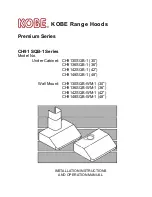
Electric Power Supply Requirements
Installation
Your range must be electrically grounded in accordance
with local codes or, in the absence of local codes, in
accordance with the National Electrical Code
(ANSI/NFPA 70, latest edition). In Canada, electrical
grounding must be in accordance with the current CSA
C22.1 Canadian Electrical Code Part 1 and/or local codes.
A copy of this standard may be obtained from: National
Fire Protection Association 1 Batterymarch Park Quincy
pp y
q
Fire Protection Association, 1 Batterymarch Park, Quincy,
Massachusetts 02269-9101.
The power supply must be the correct polarity. Reverse
polarity will result in continuous sparking of the
electrodes, even after flame ignition. If there is any
doubt as to whether the power supply has the correct
polarity or grounded, have it checked by a qualified
electrician.
U 120V 60H
d
l
d d b
h i
i
d b
15
20
i
i
Use 120V, 60Hz, and properly grounded branch circuit protected by a 15-amp or 20-amp circuit
breaker or time delay fuse.
Grounding
1.
The power cord is equipped with a three-prong (grounding) plug which mates with a
standard three-prong grounding wall receptacle to minimize the possibility of electrical
shock hazard from the range.
2
Where a standard two prong wall receptacle is encountered it is the responsibility and
2. Where a standard two-prong wall receptacle is encountered, it is the responsibility and
obligation of the customer to have it replaced with a properly grounded three-prong wall
receptacle. Do not cut or remove the grounding prong from the power cord.
Connect Range to Gas Supply
1. Install a manual gas line shut-off valve in the gas line in an easily accessed location outside
the range.
2
Install male ½” flare union adapter to ½” NPT internal thread elbow at inlet of regulator
2. Install male ½ flare union adapter to ½ NPT internal thread elbow at inlet of regulator.
On models equipped with standard twin burners, install the male pipe thread end of the ½”
flare union adapter to the ½” NPT internal thread at inlet of pressure regulator. Use a
wrench on the regulator fitting to avoid damage.
3. Install male ½” or ¾” flare union adapter to the NPT internal thread of the manual shut-off
valve, taking care to secure the shut-off valve to keep it from turning.
4. Connect flexible gas line connector to the regulator on the range. Position range to permit
connection at the shut-off valve.
7






































